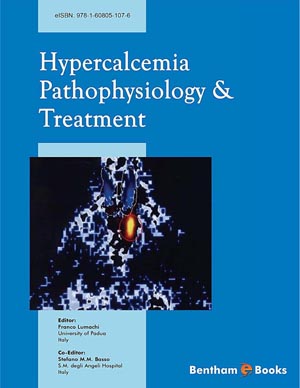Abstract
Hypercalcemia arising in cancer patients is usually referred to as malignancy-associated hypercalcemia (MAH). It may complicate early or, more often, late phases of the disease with a prevalence of around 5-30% of all patients with different types of cancer. However, the prophylactic use of bisphosphonates to prevent skeletal events in patients with bone metastases, has probably reduced the occurrence of clinically symptomatic MAH. The most frequent cause of MAH is abnormal production of a parathyroid hormone-related protein (PTHrP), which mimics the effects of parathyroid hormone, increasing bone resorption and, especially, renal tubular calcium reabsorption. Other causes may be bone lysis due to several cytokines and mediators released by the cancer cells in the bone or the ectopic production of 1,25(OH)2 vitamin D3 in tumor tissue. Periodical monitoring of serum ions in cancer patients usually unveils the onset of MAH before the appearance of the classical symptoms (headache, confusion, de-hydration), prompting adequate treatment consisting in hydration, diuretics, bisphosphonates and, whenever possible, treatment of the underlying cancer (usually with systemic chemotherapy). Bisphosphonates are a class of compounds which have all shown to decrease serum calcium levels primarily by inhibition of PTH-dependent osteoclast activation. Although, the antiresorptive potency is higher with late generation compounds (pamidronate, zolendronate, ibandronate) compared to older oral compounds. Agents able to interfere with the receptor activator of nuclear actor-κ ligand (RANKL) pathway such as the monoclonal antibody denosumab represent novel and promising strategies for the treatment of MAH which are currently undergoing experimental and clinical assessment.





















